The information in this section will help you create and edit 2.5 axis Profile Contouring operations in your manufacturing program.
Select Profile Contouring
![]() then select the geometry to be machined
then select the geometry to be machined
![]() .
.
A number of strategy parameters
![]() are available for
defining:
are available for
defining:
Specify the tool to be used
![]() ,
NC macros
,
NC macros ![]() , and
feeds and speeds
, and
feeds and speeds ![]() as needed.
as needed.
|
Tool path style Indicates the cutting mode of the operation:
|
|
|
Direction of cut Specifies how machining is to be done. |
|
| In
Climb milling, the front of the advancing tool (in the machining
direction) cuts into the material first.
|
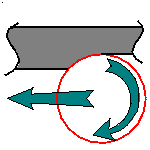 |
| In Conventional , the rear of the advancing tool (in the machining direction) cuts into the material first. |
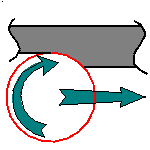 |
|
Machining tolerance Specifies the maximum allowed distance between the theoretical and computed tool path. |
|
|
Fixture accuracy Specifies a tolerance applied to the fixture thickness. If the distance between the tool and fixture is less than fixture thickness minus fixture accuracy, the position is eliminated from the trajectory. If the distance is greater, the position is not eliminated. |
|
|
Type of contour Indicates whether the contouring type of corners is: |
|
| Circular: the tool pivots around the corner point, following a contour whose radius is equal to the tool radius |
 |
| Angular: the tool does not remain in contact with the corner point, following a contour comprised of two line segments |
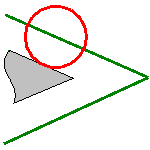 |
| Optimized: the tool follows a contour derived from the corner that is continuous in tangent |
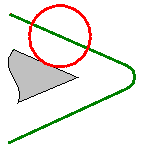 |
|
Forced circular: This option may be used in certain complex cases when
the Circular option does not give satisfactory results. It creates tool paths comprising of portions of circular arcs (for example, when grooves are present along the trajectory and the tool is too big to penetrate). |
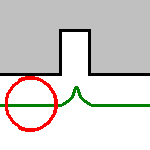 |
|
Close tool path Specifies whether or not the program must close the tool path.
|
|
|
Tool position ON guide Specifies the position of the tool tip on the guiding elements. Offset on contour and driving mode are already taken into account. |
|
|
Percentage overlap Specifies the amount that the tool must go beyond the end point of a closed tool path according to a percentage of the tool diameter. |
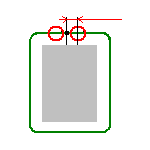 |
|
Compensation output Allows you to manage the generation of cutter compensation (CUTCOM) instructions in the NC data output in Between Two Planes machining mode. The following options are proposed:
Any user-defined PP words in macros are added to the cutter compensation instructions generated in the NC data output. Therefore you should be careful when specifying CUTCOM instructions in macros. A negative Offset on contour (parameter in Geometry tab page) is possible for 2D radial profile output.
|
|
|
Compensation Specifies the tool corrector identifier to be used in the operation. The corrector type (P1, P2, P3, for example), corrector identifier and corrector number are defined on the tool. When the NC data source is generated, the corrector number can be generated using specific parameters. |
|
|
Compensation application mode Specifies how the corrector type specified on the tool (P1, P2, P3, for example) is used to define the position of the tool: Output point or Guiding point. |
|
In a Profile Contouring, cornering for HSM is available for Roughing and Finishing passes in the following guiding modes:
Cornering applies to inside corners for machining or finishing passes. It does not apply to:
A Profile Contouring operation can be created in one of the following Machining modes.
Tool follows contour between top and bottom planes while respecting user-defined geometry limitations and machining strategy parameters.
You can specify the following Geometry:
Tool follows a trajectory defined by the Guide contour and Auxiliary Guide contour while respecting user-defined geometry limitations and machining strategy parameters.
You can specify the following Geometry:
Guide contour is used for positioning the flank of the tool (radial positioning).

Auxiliary Guide contour is used for positioning the tool tip along the tool axis (axial positioning).
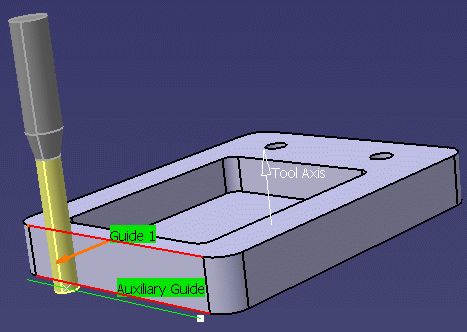
Cases when only the Guide contour is specified:

You can restrict machining to a specific zone by specifying Minimum depth and Maximum depth values. The depths are taken from the Guide contour. The Depth limitation check box must be activated in this case.
Tool follows trajectory defined by a top guide curve and bottom surfaces while respecting user-defined geometry limitations and machining strategy parameters.
You can specify the following Geometry:
You can restrict machining to a specific zone by specifying Minimum depth and Maximum depth values. The depths are taken from the top guiding contour. The Depth limitation check box must be selected in this case.
Tool flank machines vertical part surface while respecting user-defined geometry limitations and machining strategy parameters.
You can specify the following Geometry:
Guiding contours can be specified in several ways:
The guiding contour can be restricted by means of Start and Stop relimiting elements. The tool can be positioned In, On or Out with respect to a relimiting element. You can select a point or a curve as relimiting element.
A fast way to specify relimiting points is to right-click the guiding contour area in the sensitive icon of the dialog box and set the Relimitation point detection contextual command. When you select a guiding contour, its extremities will be used as relimiting elements.
Note that a relimiting point can be created anywhere along the guiding contour by means of the Add relimiting point contextual command. Just right-click the relimiting element area in the sensitive icon of the dialog box and select any position along the guiding contour.
Relimiting point selection can be made easier depending on the selected screen view. For example, you can select the Normal View icon in the View toolbar and a suitable face. The screen view is then perpendicular to the selected face and it is then easier to define relimiting point locations on the guide when moving the cursor.
You can machine several discontinuous groups of guiding elements in all Profile Contouring modes (except By Flank Contouring).
These contours can be selected using the Edge Selection Toolbar. A Guide.x element is displayed for each selected continuous ordered contour.
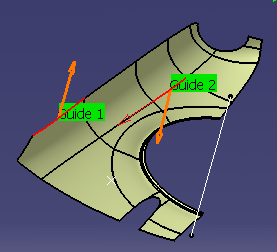
The side to mill is shown by the orange arrow. Click on the arrow to inverse the side to mill.
The order of in which the geometric elements are selected determines the order in which they will be machined.
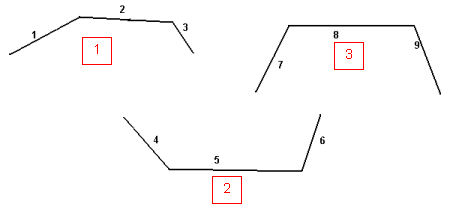
A linking macro can be used to link two discontinuous portions of the same tool path. Otherwise, a straight line is generated.
Once the selection of the guides is validated (that is, when the dialog box is displayed again), the following contextual menus become available.
On a guide in the graphic area:
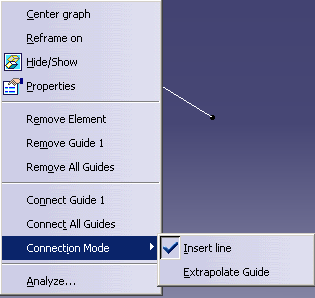
On a guide in the sensitive icon of the dialog box:
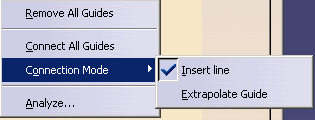
Remove Element: Removes the selected element from the Guide.
You can also remove an element by picking it again, after having launched the Edge Selection toolbar. If the guide is no longer continuous, another guide is created.
Before 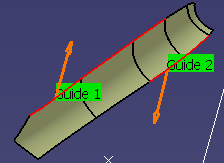 After
After
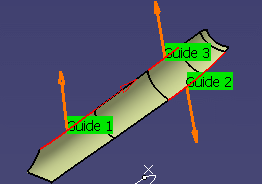
You can add elements to a guide by simply picking the element, after having launched the Edge Selection toolbar. If the element picked is connected to that guide, it is automatically added to that guide. If the element picked is connected to two guides, the element is added and the two guides are merged into one.
Remove Guide x: Removes the selected guide.
Before  After
After
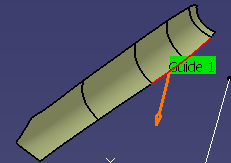
Remove All Guides: Removes all guides
Before  After
After

Connect Guide.x: Connects a guide to another one. Select the original guide, then the item Connect Guide.x in the contextual menu and the target guide.
Before 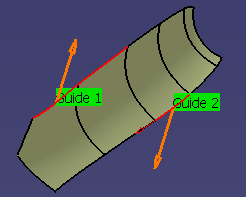 After
After
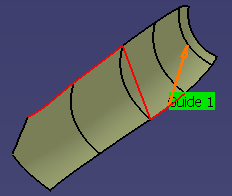
The Connection Mode allows connection either by inserting a line or extrapolating a contour.

Connect All Guides: Connects all guides into one.
Before 
After 
Collision checking is done during macro motions and machining motions (for corner and angle contouring). All guiding elements defined on the operation are taken into account during this verification. However, in some cases, it can be useful to deactivate collision checking with the guides (see example below).
In the following figure, collision avoidance during the
circular approach macro is not necessary.
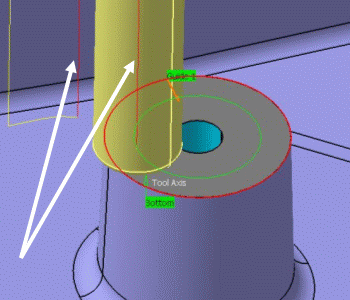
In the following figure, there is no collision avoidance during
the circular approach.
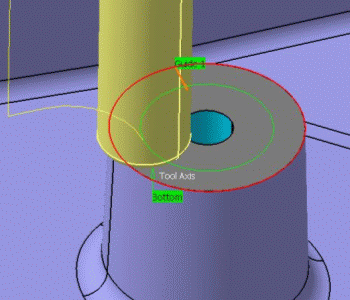
The Collision Avoidance capability allows you to manage this collision checking.
When you select Collision checking on the Geometry tab page, the following dialog box appears.

When the Include guiding elements check box is selected, guides are checked for collisions during macro motions and machining motions. By default, the check box is selected.
When the check box is not selected, no collision verification is done with the guides for macro motions and for machining motions during tool plunges.
In the specific case when there is no selected top element and no offset defined on the bottom element, there is no tool motion to avoid the guiding elements, so no collisions will be detected (for macro motions only).
Recommended tools for Profile Contouring are End Mills, Face Mills, Conical Mills and T-Slotters.
Drills, Spot Drills, Center Drills, and Countersinks can also be used.
In the Feeds and Speeds tab page, you can specify feedrates for approach, retract, machining and finishing as well as a machining spindle speed.
Feedrates and spindle speed can be defined in linear or angular units.
A Spindle output check box is available for managing output of the SPINDL instruction in the generated NC data file. If the check box is selected, the instruction is generated. Otherwise, it is not generated.
Feeds and speeds of the operation can be updated automatically according to tooling data and the Rough or Finish quality of the operation. This is described in Update of Feeds and Speeds on Machining Operation.
You can reduce feedrates in corners encountered along the tool path depending on values given in the Feeds and Speeds tab page: reduction rate, maximum radius, minimum angle, and distances before and after the corner.
Feed reduction is applied to corners along the tool path whose radius is less than the Maximum radius value and whose arc angle is greater than the Minimum angle value. Corners can be angled or rounded.
For Profile Contouring, feedrate reduction applies to inside corners for machining or finishing passes. It does not apply for macros or default linking and return motions.
If a cornering is defined with a radius of 5mm and the Feedrate reduction in corners set to a lower radius value, the feedrate will not be reduced.
You can define transition paths in your machining operations by means of NC Macros. These transition paths are useful for providing approach, retract and linking motion in the tool path.
An Approach macro is used to approach the operation start point.
A Retract macro is used to retract from the operation end point.
A Linking macro may be used in several cases, for example:
A Return on Same Level macro is used in a multi-path operation to link two consecutive paths in a given level.
A Return between Levels macro is used in a multi-level machining operation to go to the next level.
A Return to Finish Pass macro is used in a machining operation to go to the finish pass.
A Clearance macro can be used in a machining operation to avoid a fixture, for example.
Note: When a collision is detected between the tool and the part or a check element, a clearance macro is applied automatically. If applying a clearance macro would also result in a collision, then a linking macro is applied. In this case, the top plane defined in the operation is used in the linking macro. The top plane element must be selected in order to apply an automatic linking macro without collision.
You can modify the parameters of several Profile Contouring operations in one shot as follows:
Note that P2 functionalities for Profile Contouring include Automatic
Draft Angle, all Finishing parameters, and Sectioning for guiding element
selection.
To edit in P1 a Profile Contouring operation that was created in P2,
the following parameter values must be set: